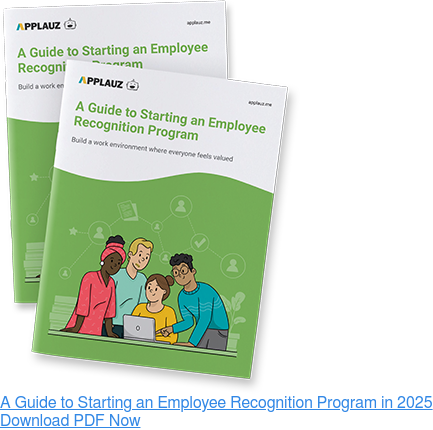There was a time where employees could expect to be recognized and rewarded only a handful of times during their tenure. But now, the world of work has drastically changed.
Employees are unlikely to stay with a company long enough to make it to a 5-year milestone. And workers, especially younger generations, don't want to wait an entire year to be officially recognized.
It's no surprise, then, that rewards and recognition spaces are thriving. Many businesses understand the value of appreciation. And are ultimately looking for technology to help their company support continuous employee recognition.
A better way to filter through options
That said, with every movement in the HR space, comes a flurry of technologies. And with so many options on the table, it can be difficult to choose the best one.
In the end, many HR teams end up selecting the most obvious brand or the one with the best-looking design. However, making decisions about your HR tech purely on surface-level factors is not always advisable.
Each recognition and reward tool is created a little differently. Before you start writing out a list of vendors, it is essential to know your basic "must-haves."
In this article, we'll help you come up with your "must-haves." By going over common questions and considerations, you should ask yourself before selecting an HR provider.
Whether you're picking out recognition software for the first time or rethinking the system you're already using. This article will give you an overview of the process and information to compare options. With this knowledge, you'll be in the best position to invest in the right software for your business.

6 Factors to Consider Before Choosing Employee Recognition Software
Know the difference between structured and unstructured recognition programs
Before looking at any software, you must ask yourself what type of recognition program you want to launch?
If you’re unsure, it helps to understand how all recognition programs fall into two main categories -- structured and unstructured. And then decide which you want to prioritize first.
Structured recognition programs are more traditional. These programs often take a top-down approach. Meaning, managers or senior leaders offer gratitude to employees. We label these programs “structured” as they are official and formal.
- For example, the most common structured recognition are rewards for top performance (e.g. an employee of the month) or work anniversary programs.
On the other hand, unstructured recognition is a relatively new concept. But it’s quickly becoming a popular employee recognition method. In these modern recognition practices, companies offer employees a dedicated space for spontaneous gestures of appreciation. And employees can give recognition in any direction, even to their managers!
- For example, a Peer-to-Peer recognition program is considered to support unstructured forms of recognition.
Suppose you already have systems that support structured recognition, like a work anniversary program. In that case, you’d likely be looking for a tool that primarily does Peer-to-Peer recognition well.
On the other hand, you might not have any recognition systems in place.
If that’s the case, you might want to start with a work anniversary program. A structured program is an ideal foundation for building a strong culture of recognition. And you can focus on finding a recognition software that specializes in Service Awards solutions.
That said, if you are thinking long-term, you want to consider implementing both structured and unstructured programs. With this strategy, finding a provider, like Applauz, that supports both Peer-to-Peer and Service Awards is necessary. You can easily start with one. And, over time, transition into using both.
Consider your budget
Although this is an obvious point to mention, it's one of the most critical. It's just like making any other large purchase. Having a budget in mind while you shop is important. This way, you can eliminate any options that fall outside your budget quickly.
That said, determining a budget for rewards and recognition is relatively straightforward. SHRM recommends that HR departments spend at least 1% of payroll on rewards and recognition. However, some companies are known to spend more, between 1% - 3%.
Your budget will influence the type of program and tool you use to go forward. As such, it's essential to choose a platform that has the flexibility to adjust to your budget, as it may grow over time.
Are you looking for recognition, rewards, or both?
Sometimes we talk about recognition and rewards as if they're the same concept or even interchangeable. However, they are very different, especially when it comes to recognition software.
In the HR tech space, you will find recognition tools that only allow employees to recognize each other with words on a company Newsfeed. But other more robust recognition tools rewards as well. For example, employees can recognize each other with points, and those points can be redeemed for real gifts from a rewards catalogue atalogue.
As such, an important baseline factor to consider is if you want recognition, rewards, or both?
Naturally, systems that offer points-based rewards will be more costly than just regular recognition as there are fees associated with purchasing points.
If your budget allows it, adding Points and rewards to a recognition program can be highly beneficial.
Some research has shown that offering employees points-based incentives throughout the year can be highly motivating and boost engagement at a much higher rate.
On the other hand, you might not be ready to invest in rewards. That's ok too! You can always test out a simple Peer-to-Peer system and slowly adopt Points as your recognition program grows.
Public vs private recognition
Many Peer-to-Peer recognition tools feature a social media style Newsfeed where recognition messages are posted and “broadcast” for everyone to see. While this can be very motivating for some employees, others might not be as comfortable with being singled out, even for positive reasons.
You know your workforce best. If you believe that having the option to give private appreciation is important, be sure to pick a recognition tool that supports this type of recognition.
Consider which HR tools you already use
Many recognition systems integrate with popular HR tools — for example, HRIS or payroll systems like BambooHR and ADP.
Integrations allow you to set up your recognition system without any hassle, as all the information is synced from the tools you already use. And most importantly, integration keeps both systems connected, so you don't have to worry about manually updating both.
That's why it's handy to keep a list of the HR and work tools you and your employees already use. So when you are shopping for a recognition provider, you can know right away if the system works with the technology you already have in place.
Consider your need for additional employee engagement tools
tools
Recognition is often just one piece of a larger company goal of improving employee engagement levels. That's why many recognition solutions don't only do recognition but also boast additional engagement features.
For example, many recognition tools also provide features that help with employee surveys, performance management, and career development.
When shopping for recognition software, it's important to consider if your business needs these additional features. Some of them can be incredibly useful to your overall engagement strategies, such as employee surveys and performance management.
Overview: Things to Consider
- Type of recognition you want to support: are you looking to put a structured system like a work anniversary or milestone program in place? Or, are you looking to invest in more spontaneous forms of recognition with a Peer-to-Peer style program?
- Budget limitations: What type of budget are you working with. Having a rough budget in mind will help you eliminate options quickly.
- Do you want recognition, rewards, or both?: Some recognition software can do both, but not all. So it’s essential to understand this baseline feature of your program.
- Private vs public recognition: Having the option for private recognition can be important to some people who may feel shy to receive public praise. Make sure the system you choose supports private recognition if you think your company would benefit from it.
- Integration with your current HR tools: If you already have an HRIS in place or a payroll software like ADP, consider looking for software that integrates with your existing tools. This effort will greatly simplify the administration of your recognition program.
- Employee engagement features: Consider if your company would benefit from other employee engagement features, like Pulse Surveys or performance management tools.
About the author
 Michelle Cadieux
Michelle Cadieux
Michelle is a content writer for Applauz. She holds a Bachelor's degree in Psychology from Concordia University, and she has been writing about work and employee happiness for over five years.



